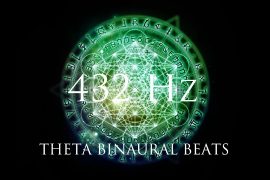What Is A Binaural Beat? – Meditation and spiritual development
In trance with binaural beats
Put headphones on your head, lie down in a relaxed way and within a few moments you will be totally relaxed and zen. That would be the effect of binaural beats. Two tones that differ by a few hertz and that bring your brain to a certain frequency.
For example, the frequency that you relax or in a meditative state. Since I-Doser, the use of binaural beats has also been popular among young people. What are binaural beats, and how does it work?
What is a binaural beat
You listen to Binaural beats on headphones. The difference between the tone on the left and the right ear differs. This difference is small, between 1 and 38 Hz. That difference causes your brain to hear a third pulsating tone. For example: the left has a 150 Hz tone and the right 156 Hz. Then you hear a third tone with a pulse of 6 Hz, or six pulses per second.
What is the effect?
Your brain itself produces brain waves caused by electrical currents caused by brain activity. The brain waves vibrate at different frequencies depending on the activity.
- 0 – 4 Hz Delta waves: when you are in deep sleep.
- 4 – 8 Hz Theta waves: during light sleep, REM sleep and daydreaming, or in a state of trance or hypnosis.
- 8 – 14 Hz Alpha waves: in a relaxed state, while visualizing and fantasizing.
- 14 – 38 Hz Beta waves: with concentration, focus, being actively present. When you are stressed, your brain mainly produces beta waves. In good balance, the brain waves provide mental focus.
By listening to binaural beats you can stimulate the brain to produce brain waves with the same frequency. When using alpha, theta or delta waves you can relax faster, get into a meditative state or sleep better.
How do you use binaural beats
To hear the pulsating tone, the use of headphones is essential. In addition, it is important that you lie down or sit in a relaxed position and that you are not disturbed. In this way you give yourself the chance to get into the desired state of mind. You don’t have to use a high volume to have an effect. A soft, pleasant volume is fine. Most binaural beats have a length of 20 to 40 minutes, but you can also find them of longer duration. You can even find songs to sleep on on YouTube. These often last eight to nine hours.
Does it really work?
There are just as many studies that claim that binaural beats work, as studies that prove the contrary. It is a matter of trying. To experience the effect, give yourself the time to work with it. That way you know quickly enough if it is for you.
Many people have to get used to the tone or the pulsating effect in the beginning. Some songs use high or very low tones, which often do something with your hearing and experience. You can continue as long as you have no other headache or other unpleasant experience.
I doser and Hemi sync
Two well-known names in the field of binaural beats are I-doser and Hemi-sync. Hemi-sync often uses guided meditations to guide you to the desired mood or state of mind, but also has instrumental versions and music including binaural beats. Hemi-sync works with different themes such as meditation, out of body experience, lucid dreaming, improving memory and concentration, rejuvenation and more.
I-doser is a somewhat “hip” variant and also aimed at young people. It is a music program where you choose the beats for the desired effect. I-doser comes with a list of very extensive effects. This also includes the effect that various drugs can have, such as marijuana and opium.
Meditation and spiritual development
Binaural beats can be a means to promote your meditation and spiritual growth. But it is not a panacea. Just lie down with headphones, you will not spontaneously relieve or rise to the level of an ascended master. In meditation and spiritual growth, the most important thing is one’s own focus and intention.
Are binaural beats dangerous?
As far as we know, binaural beats are harmless. However, every creator of binaural beats does not hold himself responsible for any effect whatsoever. Binaural beats are not a substitute for medication or treatment, but can, according to the makers, have a supportive effect. In addition, you always read the warning not to listen to the beats while driving or operating machines.
Reference:

